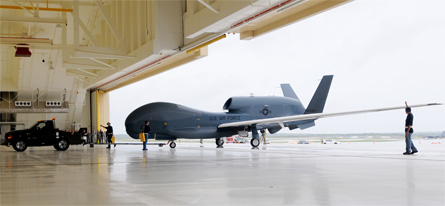Despite a dismal initial operational test and evaluation (IOT&E) report about the Northrop Grumman RQ-4 Global Hawk Block 30, the US Air Force reports a relatively high operational reliability rating.
The USAF reports that Block 30 Global Hawks, operating from four bases for five combatant commands, are operating with 76% reliability. The real-world operational rating contrasts dramatically with a 20 May IOT&E report that pegged reliability at 27%.
The figures provided by the air force "are indicative of RQ-4 continued operations tempo in theatre and demonstrated mission effectiveness", and do not reflect past performance. The USAF indicated that current capability was improved by fixes to problems detailed in the report, but further specifics were not immediately available.
 |
|---|
© US Air Force |
Northrop attributed the difference to operational training and spare parts availability, issues the air force singled out in the IOT&E report. Frontline units generally receive higher priority for new parts when they become available.
"There's a point where you can't build spare parts fast enough because your decision to fund those is two years old," said Ed Walby, Global Hawk programme manager at Northrop. "And some parts take a year to produce."
Of the nine critical issues cited by the USAF, six have been fixed, according to Walby. Among the three outstanding issues are nutplate failures near frequently-accessed areas, which resulted in the majority of air vehicle failures and can take a full day to fix.
"Unless you're very specific about how you clean the surface when that nutplate is glued to a cowling or a panel, we were starting to see disbonding," said Walby. "We knew about that going into IOT&E and sure enough, in IOT&E you had some of those coming off. It's a matter of your quality control. So we changed some procedures in manufacturing to make sure those surfaces are clean."
Northrop expects fixes to problems identified by the report to have little impact on remaining Block 30 manufacturing, nor on the Block 40s currently being produced.
Incomplete maintenance training and related documentation were also singled out in the IOT&E report. "If you look at the number of sorties, the 19 sorties flown, you see a drastic learning curve," noted Walby. "I think about the last eight or nine sorties were almost flawless." Confirmation from the USAF was not immediately available; maintenance was carried out during the evaluation by personnel from the 9th Reconnaissance Wing, which operates the RQ-4.
Source: Flight International




















